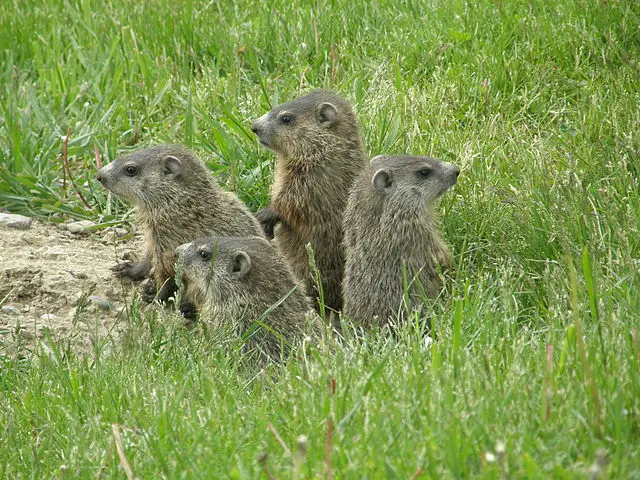 Groundhogs, also known as woodchucks are the largest members of the family of squirrels. They are called by other names like land-beaver and whistle pig. Although they are known to live on land, they can swim and climb trees too to escape predators.
Groundhogs, also known as woodchucks are the largest members of the family of squirrels. They are called by other names like land-beaver and whistle pig. Although they are known to live on land, they can swim and climb trees too to escape predators.
Fact1. The scientific name of groundhog is Marmota Monax. On an average its size is 20 inches long and weighs between 6 to 12 pounds. It has a long tail of about 6 to 7 inches and has a lifespan of 3 to 6 years in the Wild.
Fact 2. Features of a Groundhog:
The special features of a groundhog are its brown furry body that is round in shape with a small bushy tail. The legs are short with sharp curved claws but are very strong and help them to burrow into the ground. Two round eyes adorn the flat head and the two long incisors that seem to grow longer every day is a unique feature of the groundhog.
Fact 3. The Homes of Groundhogs
Groundhogs are mostly found in the eastern and central part of the United States and also some parts of Alaska and Canada. They actually love to stay in transitional areas where at the end of the forest there is a meadow. Their burrows are complex in nature and they spend a lot of time there. These burrows are dug in the well-drained soil which is dry near covers like hedgerows, structures, fencerows, trees and home foundations.
Fact 4. Food Habits of a Groundhog
A groundhog is known to be an herbivore. It eats about 1/3 of its weight of vegetation regularly. But sometimes it eats the insects that come its way, otherwise not. The groundhog is very intelligent and that it will need food during the winter and so in summer and fall, it increases its consumption of food to store fat for the winter. Its favorite foods include apples, beans and peas, garden vegetables, clover, barks of trees etc.
Fact 5. Behavior of Groundhogs
Groundhogs are very active during the daytime in spring to fall. In the early mornings and early evenings they come out of their burrows in search of food. They dig their own burrows with the sharp claws which have multi-chambers including bathrooms. In these chambers they store food, build their nest and hibernate throughout the winter.
Fact 6. Hibernation is practiced in the true sense of the term by the groundhogs. They go off to sleep in October and peep out of their burrows in early spring. It is amazing to know that the groundhog’s temperature goes down to 40 degrees F and heart beat is as slow as 80 beat a minute. Moreover, it is not fond of socializing and look for other groundhogs with the intention of mating only. But they have great unity and when they sense danger, they make a shrill sound to warn others.
Fact 7. Destructive nature of groundhogs
Groundhogs pose great problems for householders, agriculturists and building contractors. Hence it is very important to be aware of the signs of damages created by groundhogs. The main signs that point to the damages caused by groundhogs are namely:
- They bite the woods, plantings and also the lower branches of the trees with their sharp wide teeth.
- The entrance of a burrow has mounds of soil.
- Hollowed or damaged crops.
- Deep holes in the ground or dry soil indicate their presence.
- Wires, tubing or irrigation pipes and systems are chewed by these groundhogs.
- Claw markings of the groundhogs are quite profound and often leave marks of five front toes and four back toes.
Although these groundhogs are not seen very often, they are very popular with kids for their cute nature of scurrying into their burrows.










Leave a Reply